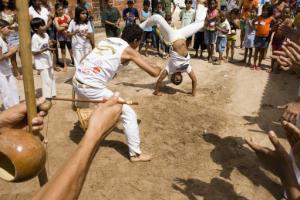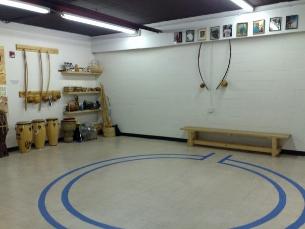The Fight Within the Capoeira Roda
What is a capoeira fight and the capoeira roda?
These are questions everybody learning about capoeira asks at some point.
 Simply put, the fight in capoeira is called a jogo or game. Those participating in the game are the capoeiristas or players. The jogo is the equivalent of sparring in other martial art systems, however in practice it is much different than sparring...
Simply put, the fight in capoeira is called a jogo or game. Those participating in the game are the capoeiristas or players. The jogo is the equivalent of sparring in other martial art systems, however in practice it is much different than sparring...
During the jogo, the players use the movements they've trained to both attack and defend. The main purpose of the jogo is not for one to 'beat' the other or kick their butt. Instead the point is to interact with the other person, setting them up for your movements and using their movements to determine your moves.
Players can hurt each other, but that's not the goal. It's more like a physical game of chess, where each movement has purpose and effects both players.
Another major difference from normal sparring is the roda...
Roda in Capoeira
 Roda is a Portuguese word meaning circle, which is simply what the capoeira roda is. It's a physical circle made up of capoeiristas clapping and singing or playing instruments.
Roda is a Portuguese word meaning circle, which is simply what the capoeira roda is. It's a physical circle made up of capoeiristas clapping and singing or playing instruments.
The roda is where the actual capoeira fight or jogo takes place. It's within this circle that the two players use what they've learned in a game with each other.
The 'entrance' of the roda is in front of those playing the instruments, specifically in front of the
berimbau
player. This is the point where people enter, leave and restart the game.
The roda is important in that it provides the structure to play and also the energy and support for the capoeiristas.
While the setup seems simple, the basic rules of the capoeira fight are more involved...
Basic Rules of the Jogo
I remember how confused I was the first time I was in a capoeira roda.
I didn't know where to stand or move!
Over time I learned the basics and with practice they became second nature. Here are some general guidelines to follow in the roda, so you don't feel like a fish out of water...
- Starting the Game – You can start playing in the roda in two ways, either being picked or buying the game. In being picked, the
mestre
or instructor will pick out those to play the games. When buying, capoeiristas at the front of the roda gesture to those playing in order to get in or 'buy' the game.
- Entering the Roda – There are a lot of variations in entering the roda. The most common is to start at the front of the roda, crouching in front of the instruments with the other player. From here both players au, or cartwheel, into the center of the roda and begin the game.
- Ending the Game – There are a couple main ways to end the game when you're in the roda. You can be called out by the berimbau. This is where the mestre ends the current game with certain tones on the berimbau. Another way is to be bought out, where another player buys the game, allowing you to leave.
- Leaving the Roda – To physically exit the roda, players return to the front where they entered, and exit from the side. The players can either au to the front or walk, depending on the instructor.
- Keeping the circle – It's important for those in the roda to keep the circle as players enter and exit. When players enter the roda, those remaining should shift closer to the front of the roda while keeping the circle intact.
- Participate – When not playing a game, the capoeiristas in the roda should participate in the clapping and singing. This keeps the positive energy going making the roda better for all within it.
- Rotating instruments – If you know how to play the capoeira instruments, make sure to rotate with the people playing them. This is a good way to catch your breath if you're tired from playing. It also relieves those playing and allows them to play a game in the roda.
These simple guidelines will go a long way in actually playing in the roda and getting started. The best way to learn them is to use them, so get out there and try!
Return from Capoeira Roda to What Is Capoeira?
Return to Start Playing Capoeira



 Simply put, the fight in capoeira is called a jogo or game. Those participating in the game are the capoeiristas or players. The jogo is the equivalent of sparring in other martial art systems, however in practice it is much different than sparring...
Simply put, the fight in capoeira is called a jogo or game. Those participating in the game are the capoeiristas or players. The jogo is the equivalent of sparring in other martial art systems, however in practice it is much different than sparring... Roda is a Portuguese word meaning circle, which is simply what the capoeira roda is. It's a physical circle made up of capoeiristas clapping and singing or playing instruments.
Roda is a Portuguese word meaning circle, which is simply what the capoeira roda is. It's a physical circle made up of capoeiristas clapping and singing or playing instruments.